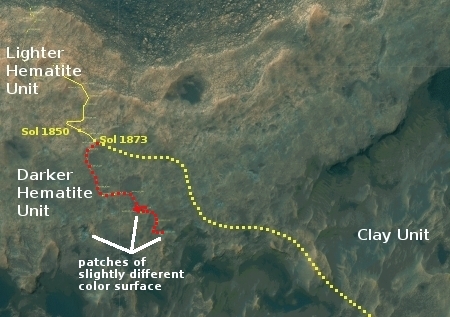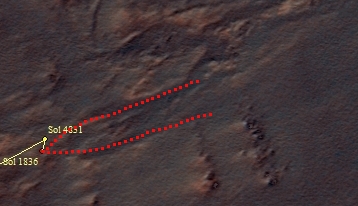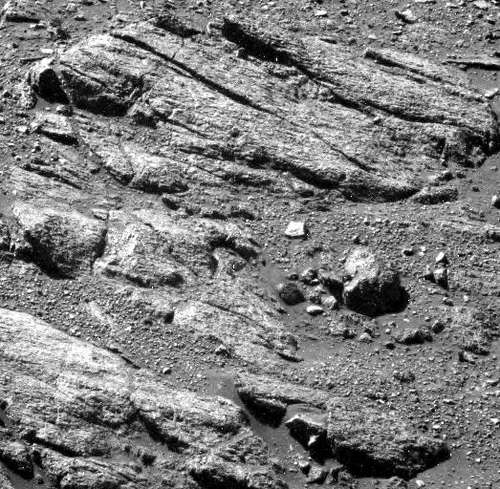Mars rover update: January 16, 2018
Summary: Both rovers have moved little in the past month, Opportunity because it is in a good science location and because it must save energy during the winter and Curiosity because it is in a geological location so good the scientists appear to almost be going ga-ga over it.
Curiosity

For the overall context of Curiosity’s travels, see Pinpointing Curiosity’s location in Gale Crater.
In the month since my December 18 update, Curiosity has continued to head south rather than east as originally planned (as indicated by the dotted yellow line in the traverse map to the right). Moreover, the rover has not moved very much, because the science team has decided that there is just too much significant geology in this area on Vera Rubin Ridge, also part of a geological unit they have dubbed the Hematite Unit.
Right now the rover is located at an area they call “Region e,” one of the three patches I have also indicated on the image to the right. From the second update below:
This location is a slight depression with exposed fractured bedrock that appears more “blue” from orbit than the surrounding region. In addition, the orbital evidence and observations from the ground suggest that this location is similar to “Region 10” that we visited just last week, which was shown to have some pretty spectacular small-scale features that were of particular interest to many on the science team. As a result, the team was very excited to reach “Region e” and begin our scientific investigation!
The last few updates on the Curiosity mission update page indicate the excitement the geologists have for this site:

- Sols 1927-1928: Layers of fun!
- Sol 1931-1933: Image Overload!
- Sols 1934-1936: Science at Location “e” of the Vera Rubin Ridge Campaign
Reader Phil Veerkamp clued me in on one particular intriguing image, taken by Curiosity’s Mars Hand Lens Imager (MAHLI) during this time period. I have posted it on the right, cropping the image to focus on the circular geological features at its center.
As I noted to Phil, I have seen circles formed naturally in caves. Water dripping on fine sand will cause a circular splash ring around it. That these features are not all circles does not matter, as splash rings will only look like circles when viewed from directly above. If the ground is uneven they can appear quite distorted from other viewpoints.
The curved rings in the image to the right however appear to be a protruding features, not a splash depressions. While I can think of a process that would fill in such splash rings with harder material and then leave behind a protruding ring after the fine sand erodes away, I have no idea what geological process would create all these curved features. Moreover, I must remind everyone that I am only an amateur geologist. I am sure the real experts on the Curiosity science team have much better theories. I also am sure that they themselves are also a bit baffled.
Opportunity
For the context of Opportunity’s recent travels along the rim of Endeavour Crater, see my May 15, 2017 rover update.

Not much has changed in the month since my last update Because of the winter season at Opportunity’s location, the rover has limited sunlight available for its batteries. If the scientists move it, they only move it in small increments.

One decision has however been reached by the science team. Last month they were trying to decide which of the two routes, as indicated by the red dotted line in the image on the right, they would take down into Perserverance Valley towards the floor of Endeavour Crater.
They have now chosen the northern route, which is exciting because from the traverse image it looks more rugged which means it will have more interesting geology to look at. (Note that though the title of the update at this link says they took the right or south fork, while the text says they took the northern or left fork, I have confirmed that it is the north fork that they have chosen. I expect them to sooner or later correct the update’s title.)
Below is just one image of the many they have taken in recent days. It shows once again the evidence of a consistent directional flow, resembling to my eye slickenslides, features that on Earth are caused by glaciers scrapping on the ground. At the moment however I have been told that the team so far favors wind as the cause of many of these features, though this consensus can of course change with time.

On Christmas Eve 1968 three Americans became the first humans to visit another world. What they did to celebrate was unexpected and profound, and will be remembered throughout all human history. Genesis: the Story of Apollo 8, Robert Zimmerman's classic history of humanity's first journey to another world, tells that story, and it is now available as both an ebook and an audiobook, both with a foreword by Valerie Anders and a new introduction by Robert Zimmerman.
The print edition can be purchased at Amazon or from any other book seller. If you want an autographed copy the price is $60 for the hardback and $45 for the paperback, plus $8 shipping for each. Go here for purchasing details. The ebook is available everywhere for $5.99 (before discount) at amazon, or direct from my ebook publisher, ebookit. If you buy it from ebookit you don't support the big tech companies and the author gets a bigger cut much sooner.
The audiobook is also available at all these vendors, and is also free with a 30-day trial membership to Audible.
"Not simply about one mission, [Genesis] is also the history of America's quest for the moon... Zimmerman has done a masterful job of tying disparate events together into a solid account of one of America's greatest human triumphs."--San Antonio Express-News


“Summary: Both rovers have moved little in the past month,”
So, who is afraid that a $3 billion rover robot operated by a whole team, will take your job? To mix in that absurd economic “debate” against automation and robotization into this.
I don’t see Curiosity swear and go getting the sledge hammer to get the stuff fit in the corner, like every craftsman does. It doesn’t even cleanse its little drill from that grain of sand that blocks it. Helpless little robot, and some people think that it is the Skynet end of our civilization. I think we are born with a compartment in our brains that WANT to believe that, and any other doomsday myth, and that some are worse than others to contain this primitive instinct.
What happened to Mars:
Prophetically, in his book, “Worlds in Collision” Immanuel Velikovsky
https://en.wikipedia.org/wiki/Immanuel_Velikovsky
stated, well before any probe had ever landed there, that Mars would a ruined world, that there would be no civilization there and precious little water. His explanation of why, based on interpretations of myth and folklore, created one of the more miserable episodes in academic tyranny, The Velikovsky Affair, spoken of in the above article.
I believe his work deserves a revisit. It is all very good reading, well written and well sourced. No one has ever been able to any more to his theory than the usual cheap “debunking” seen in the treatment of UFO sightings. Check them out if for no other reason than they are fun.
https://www.amazon.com/s/ref=nb_sb_ss_i_2_10/133-9971760-2948515?url=search-alias%3Dstripbooks&field-keywords=immanuel+velikovsky+books&sprefix=Immanuel+V%2Caps%2C146&crid=10RQUI3G11PJX
apologies:
I hurried my post and left out odd bits of words.